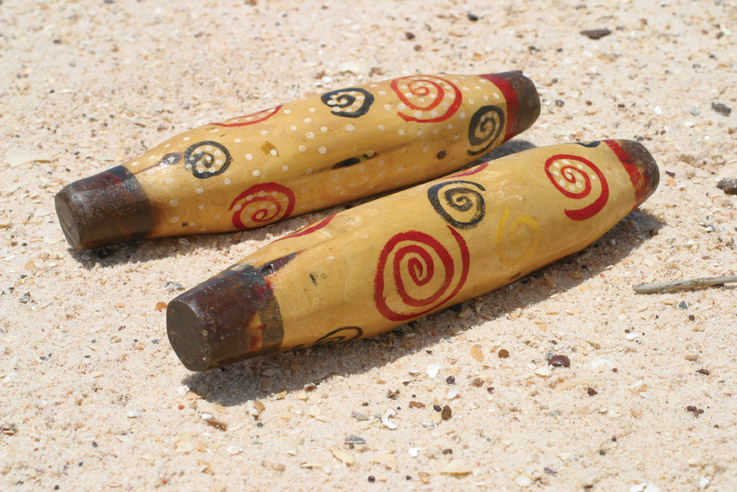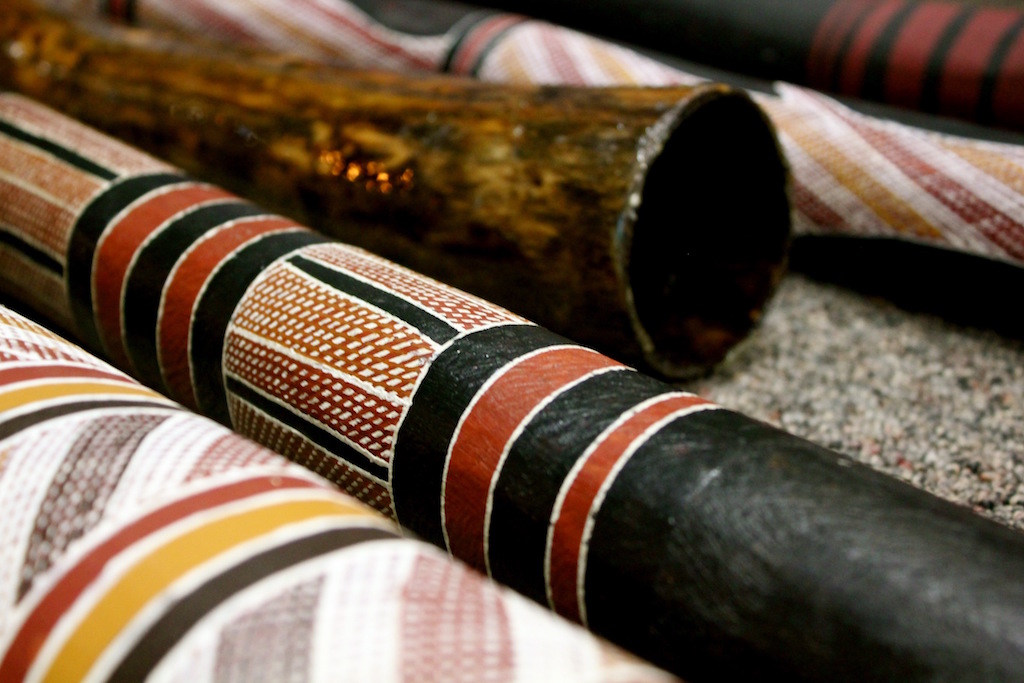The Rhythms of the Earth: A Journey Through Aboriginal Musical Instruments
The Rhythms of the Earth: A Journey Through Aboriginal Musical Instruments

The world of Aboriginal music is a vibrant tapestry woven with the threads of tradition, spirituality, and connection to the land. At its heart lie the instruments, crafted with skill and imbued with meaning, that carry the stories, songs, and dances of generations past. These instruments are not mere tools for making sound; they are extensions of the spirit, voices of the ancestors, and tangible links to the ancient wisdom of the First Nations people of Australia.
A Symphony of Sounds: Exploring the Diverse Instruments
Related Articles: The Rhythms of the Earth: A Journey Through Aboriginal Musical Instruments
- The Didgeridoo: Australia’s Iconic National Instrument
- The Buzz About Stingless Bees: Exploring Australia’s Unique Pollinators
- Unveiling The Power Of Aboriginal Face Masks: A Journey Through Art, Ceremony, And Cultural Significance
- Unveiling The Secrets: A Journey Into The World Of Aboriginal Masks
- Leaping Through Time: Exploring The Significance Of Kangaroo Aboriginal Paintings
Aboriginal musical instruments are as diverse as the landscapes they inhabit, each region boasting its own unique repertoire of instruments and playing styles. From the wind-swept deserts to the lush rainforests, the rhythms of the land inspire the creation and use of these instruments, each resonating with the spirit of its creators.
1. Didgeridoo: The Voice of the Earth
The didgeridoo, perhaps the most iconic Aboriginal instrument, is a long, hollow wooden tube played by blowing air through the mouthpiece and manipulating the breath to create a range of droning sounds. Its deep, resonant tone is said to mimic the sound of the earth itself, and its use is deeply intertwined with traditional ceremonies, storytelling, and healing practices.
- Origins and Construction: The didgeridoo is traditionally made from eucalyptus trees that have been hollowed out by termites. The hollowed-out log is then shaped, smoothed, and decorated with intricate designs.
- Playing Techniques: The didgeridoo is played by buzzing the lips against the mouthpiece, creating a continuous drone. By manipulating the breath and tongue, players can create a variety of sounds, including rhythmic patterns, melodic phrases, and even vocalizations.
- Cultural Significance: The didgeridoo is a powerful symbol of Aboriginal culture and is used in a wide range of ceremonies, including initiation rites, healing rituals, and storytelling sessions.

2. Clapsticks: The Rhythmic Pulse of the Land
Clapsticks, also known as "kulintji" or "yidiyidi," are simple yet powerful instruments made from two wooden sticks that are struck together to create a rhythmic beat. Their versatility allows them to be used in a variety of contexts, from accompanying dances and songs to signaling and communication.
- Construction and Materials: Clapsticks are typically made from hardwood, such as eucalyptus or acacia, and are often decorated with carvings, paint, or feathers.
- Playing Techniques: The sticks are held in each hand and struck together, creating a percussive sound. The rhythm and intensity of the strikes can vary depending on the desired effect.
- Cultural Significance: Clapsticks are used in a variety of Aboriginal ceremonies, including dance performances, storytelling sessions, and healing rituals. They also play a vital role in communication and signaling.

3. Bullroarer: The Voice of the Spirits
The bullroarer, also known as a "turndun," is a flat, wooden plank that is attached to a string and swung through the air to create a buzzing, whirring sound. Its distinctive sound is believed to represent the voices of spirits, ancestors, or the wind itself.
- Construction and Materials: Bullroarers are typically made from hardwood, such as eucalyptus or acacia, and are often decorated with carvings or paint.
- Playing Techniques: The bullroarer is held by the string and swung through the air, creating a buzzing sound. The pitch and intensity of the sound can be varied by adjusting the speed and angle of the swing.
- Cultural Significance: Bullroarers are used in a variety of Aboriginal ceremonies, including initiation rites, healing rituals, and rainmaking ceremonies. They are also believed to have the power to ward off evil spirits.

4. Bamboo Flute: The Sweet Melodies of the Bush
Bamboo flutes, known as "yira" or "digiri," are simple yet elegant instruments made from hollow bamboo stalks. These flutes are played by blowing across the top of the stalk to create a range of melodic sounds.
- Construction and Materials: Bamboo flutes are typically made from bamboo stalks that have been carefully selected and prepared. They are often decorated with carvings, paint, or feathers.
- Playing Techniques: The flute is held horizontally and blown across the top of the stalk, creating a melodic sound. The pitch can be varied by covering or uncovering holes along the length of the flute.
- Cultural Significance: Bamboo flutes are used in a variety of Aboriginal ceremonies, including dance performances, storytelling sessions, and healing rituals. They are also used for personal enjoyment and meditation.
5. Hand Drum: The Beat of the Heart
Hand drums, also known as "kulinji" or "yidiyidi," are small, handheld drums made from a variety of materials, including wood, hide, and gourds. They are used to create a rhythmic beat that accompanies dances, songs, and ceremonies.
- Construction and Materials: Hand drums are typically made from a hollowed-out log or gourd, covered with a thin skin of animal hide. They are often decorated with carvings, paint, or feathers.
- Playing Techniques: The drum is held in one hand and struck with the other hand or a stick, creating a rhythmic beat. The pitch and intensity of the sound can be varied by adjusting the tension of the skin.
- Cultural Significance: Hand drums are used in a variety of Aboriginal ceremonies, including dance performances, storytelling sessions, and healing rituals. They are also used for personal enjoyment and meditation.
6. Musical Shells: The Ocean’s Song
In coastal communities, seashells are often used as musical instruments. These shells are blown into or struck to create a variety of sounds, from delicate whispers to powerful blasts.
- Construction and Materials: Seashells used for music are typically large and hollow, such as those from conch, abalone, or oyster.
- Playing Techniques: Shells can be blown into to create a resonant sound or struck against another shell or a hard surface to create a percussive sound.
- Cultural Significance: Seashells are used in a variety of Aboriginal ceremonies, including dance performances, storytelling sessions, and healing rituals. They are also used for personal enjoyment and meditation.
7. Stringed Instruments: The Melodies of the Ancients
While less common than other instruments, stringed instruments like the "yidaki" (a stringed instrument made from a hollowed-out log) and the "wirri" (a type of lyre) have also played a role in Aboriginal music. These instruments are typically made from local materials and are played using traditional techniques.
The Legacy of Sound: The Importance of Musical Instruments
Aboriginal musical instruments are more than just tools for creating sound; they are vessels of culture, history, and spirituality. They embody the deep connection that Aboriginal people have with the land, the ancestors, and the spirit world.
- Storytelling and History: Aboriginal music is often used to tell stories, preserve history, and pass on knowledge from generation to generation. Instruments like the didgeridoo and clapsticks are used to accompany songs and dances that recount ancestral journeys, creation myths, and important events.
- Ceremonies and Rituals: Many Aboriginal instruments are used in ceremonies and rituals, such as initiation rites, healing rituals, and rainmaking ceremonies. The sounds of these instruments are believed to have the power to connect with the spirit world and invoke the blessings of the ancestors.
- Social Cohesion and Identity: Aboriginal music and instruments play a vital role in maintaining social cohesion and identity. They provide a shared language and a sense of belonging for Aboriginal people, regardless of their location or tribal affiliation.
Preserving the Heritage: The Future of Aboriginal Music
The continued use and preservation of Aboriginal musical instruments is vital for maintaining the cultural heritage of the First Nations people of Australia. In recent years, there has been a growing interest in Aboriginal music, both within Australia and internationally. This renewed interest has led to a revival of traditional music and instrument making, as well as the development of new musical forms that blend traditional and contemporary styles.
The Importance of Respect and Appreciation
It is important to approach Aboriginal music and instruments with respect and appreciation. This means learning about the cultural significance of these instruments, understanding the traditional ways in which they are played, and seeking permission before recording or performing Aboriginal music.
FAQ about Aboriginal Musical Instruments
Q: What is the most iconic Aboriginal musical instrument?
A: The didgeridoo is widely considered the most iconic Aboriginal musical instrument, known for its unique sound and cultural significance.
Q: How are Aboriginal musical instruments made?
A: Aboriginal musical instruments are typically made from natural materials found in the local environment, such as wood, bamboo, shells, and animal hide. They are often handcrafted using traditional techniques and decorated with intricate carvings, paint, or feathers.
Q: What is the purpose of Aboriginal musical instruments?
A: Aboriginal musical instruments serve a variety of purposes, including storytelling, preserving history, performing ceremonies, maintaining social cohesion, and expressing spiritual beliefs.
Q: Are Aboriginal musical instruments still used today?
A: Yes, Aboriginal musical instruments are still used today in a variety of contexts, including traditional ceremonies, contemporary music, and educational settings.
Q: How can I learn more about Aboriginal musical instruments?
A: You can learn more about Aboriginal musical instruments by visiting museums, attending cultural performances, reading books and articles, and speaking with Aboriginal elders and musicians.
Conclusion:
The world of Aboriginal musical instruments is a rich and fascinating one, filled with stories, traditions, and spiritual significance. These instruments are not only a source of beautiful sound but also a powerful symbol of the enduring cultural heritage of the First Nations people of Australia. As we continue to learn about and appreciate these instruments, we gain a deeper understanding of the history, culture, and spirit of Aboriginal Australia.

Closure
Thus, we hope this article has provided valuable insights into The Rhythms of the Earth: A Journey Through Aboriginal Musical Instruments. We thank you for taking the time to read this article. See you in our next article!


